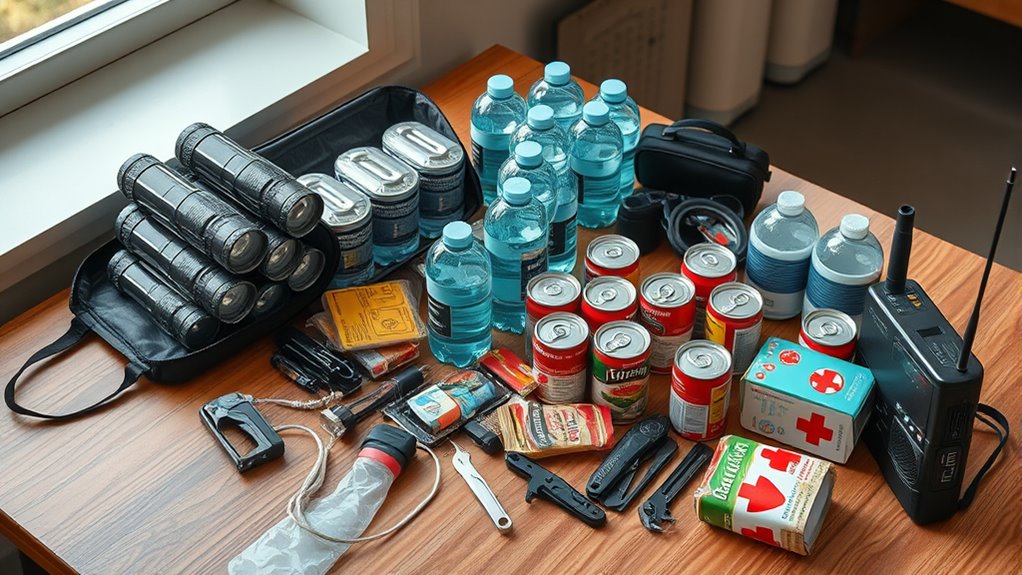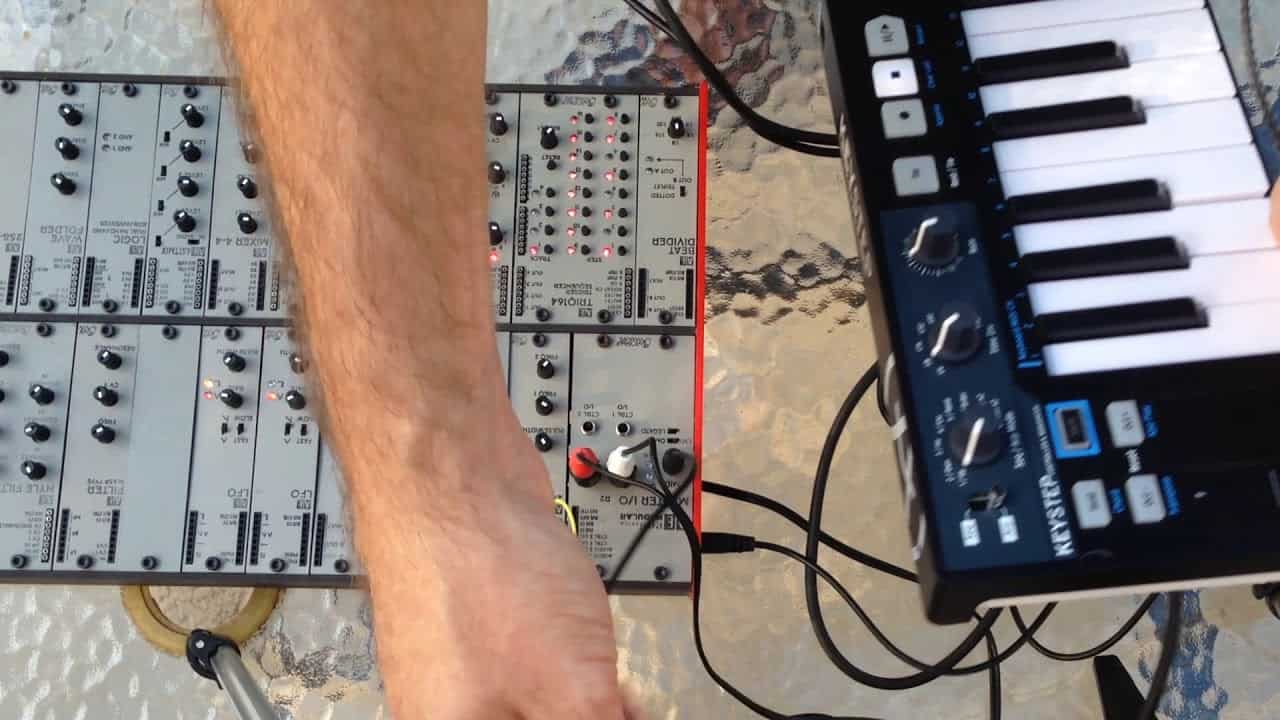To troubleshoot your emergency kit quickly, start by gathering it in a clean, organized space. Check expiration dates on food, water, and first aid supplies, replacing any expired items. Test batteries, flashlights, and radios to make certain they work. Verify communication devices and update contact details. Confirm that all tools and documents are intact and accessible. Staying systematic makes it fast to identify issues and keep everything ready—keep going to learn more tips for efficient maintenance.
Key Takeaways
- Quickly inspect and verify expiration dates on food, water, and medical supplies, replacing anything expired or damaged.
- Test communication devices like radios and flashlights, replacing batteries and ensuring they function properly.
- Organize supplies into labeled categories for easy access during emergencies.
- Conduct a rapid visual check of clothing, bedding, and tools for damage or wear, replacing as needed.
- Review and update your emergency contact list and documentation, ensuring quick retrieval and digital backups.
Gather Your Emergency Kit and Find a Clean Workspace
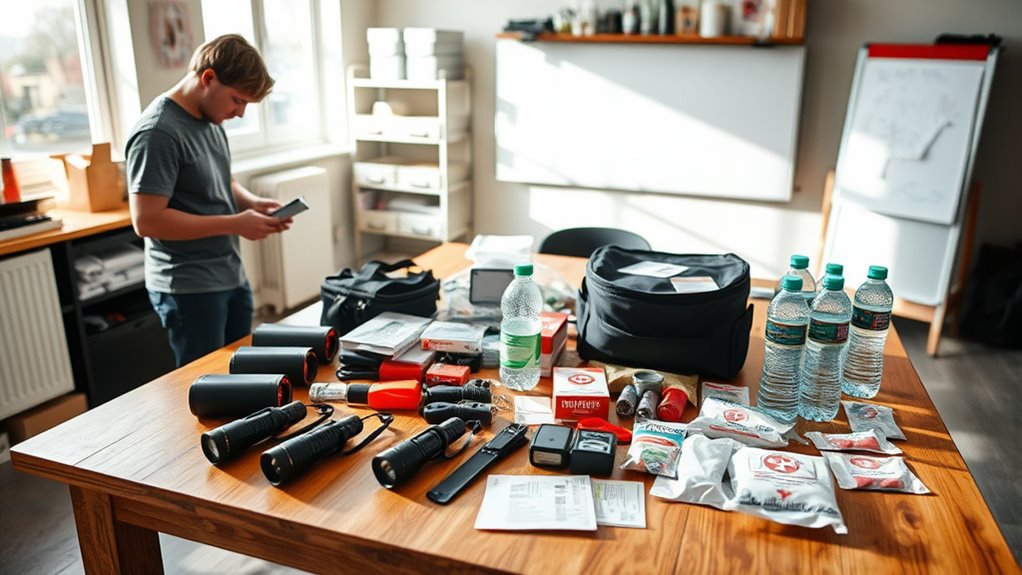
Before you begin organizing your emergency kit, find a clean, flat workspace where you can lay out all your supplies. A well-chosen area helps you see everything clearly, making it easier to assess what you have and what you still need. Good workspace organization is key; use storage solutions like bins, shelves, or trays to keep items accessible and prevent clutter. Group similar items together—food, water, first aid, tools—so you can quickly locate what you need in an emergency. Clearing the area beforehand ensures nothing gets lost or mixed up. Keep it well-lit and free of distractions, so your process is efficient. Proper workspace organization makes your kit easier to assemble and maintain, giving you confidence in your emergency preparedness efforts.
Check the Expiration Dates on Food and Water Supplies

Checking the expiration dates on your food and water supplies is a crucial step to guarantee your emergency kit remains safe and effective. Over time, food storage items can spoil, and water quality can decline, risking your safety during an emergency. To keep your kit ready, review these items:
- Canned foods and dried snacks for freshness and potency
- Bottled water, checking for cloudiness or unusual odors
- Water purification tablets or filters for backup options
- Food containers with sealed packaging to prevent contamination
Discard anything past its expiration date or showing signs of spoilage. Replace expired items promptly. Regularly inspecting your food storage and water supplies ensures your emergency kit stays reliable and safe for any situation. Proper storage materials can help prolong the shelf life of your supplies and prevent spoilage.
Inspect First Aid Supplies and Replace Used or Expired Items
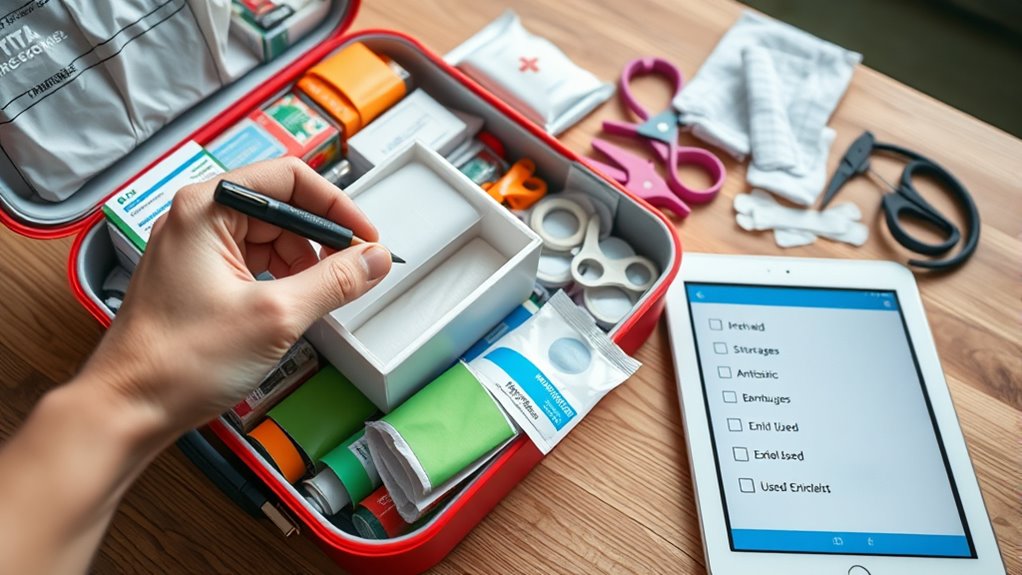
You need to regularly check your first aid supplies for expiration dates and replace any expired items. Take stock of what’s used up and restock essentials like bandages and antiseptics. Keeping your kit current guarantees you’re prepared for emergencies. Additionally, assessing the indoor air quality in your home can help identify if your environment needs further improvement to ensure overall safety.
Check Expiration Dates
Regularly inspecting your first aid supplies is essential to guarantee they’re effective when needed. Check expiration dates on all items, including bandages, ointments, and medications, and discard anything expired. Look for signs of damage or contamination that could compromise food safety and storage conditions. To keep your kit ready, ensure:
- All medications are within their expiration date.
- First aid supplies are stored in a cool, dry place.
- Perishable items, like ointments, haven’t gone bad.
- Packaging remains sealed and undamaged.
- Proper storage conditions prevent deterioration and ensure the longevity of supplies.
Replacing expired or compromised items maintains the kit’s reliability during emergencies. Proper storage conditions prevent deterioration, and regularly updating supplies guarantees you’re prepared with safe, effective first aid tools. Staying vigilant guarantees your kit is always ready when it counts.
Inventory Essential Supplies
Have you inspected your first aid supplies recently to guarantee everything is in place? Check your emergency kit for essential supplies like bandages, antiseptics, and medications, replacing any used or expired items. Review your food storage to ensure non-perishable items are intact and within expiration dates. It’s also crucial to verify your water purification supplies, such as filters or tablets, are still effective. Replace anything that’s missing or no longer safe to use. Keeping your first aid kit stocked with current supplies helps you respond quickly during an emergency. Don’t forget to confirm your water purification methods are ready, ensuring access to safe drinking water when needed. Regularly updating these supplies minimizes potential delays or complications during critical moments. Additionally, understanding best emergency supplies for pinball enthusiasts can help you prepare for unexpected situations more effectively.
Restock Used Items
When inspecting your first aid supplies, it’s essential to identify any used, expired, or missing items that could compromise your emergency response. Replace these items promptly to ensure readiness. Use effective storage solutions to keep supplies organized and accessible, reducing communication barriers during emergencies. Check for:
- Bandages and gauze that are torn or discolored
- Expired antiseptic wipes or ointments
- Missing scissors or tweezers
- Used or empty pain relievers or medications
- Ensure your kit includes color accuracy features to improve visibility and identification of supplies in low-light situations.
Restocking these items prevents delays when minutes count. Keep your supplies in clear, labeled containers to facilitate quick identification, especially when communication barriers arise. Regularly updating your first aid kit guarantees that all essential items are ready for any emergency situation.
Verify Battery Power and Functionality of Flashlights and Radios

How can you guarantee your flashlights and radios will work when you need them most? Start with a thorough battery check and radio testing. Turn on each device to ensure they power up and function properly. For flashlights, replace weak or dead batteries and test the light beam. For radios, verify they turn on and receive signals clearly. Keep spare batteries readily accessible. To stay organized, record the test results in a simple table:
| Device | Status | Next Check Date |
|---|---|---|
| Flashlight A | Working / Needs new battery | MM/DD/YYYY |
| Radio B | Clear reception / Battery OK | MM/DD/YYYY |
Regularly performing these steps guarantees your devices are operational when emergencies strike. Additionally, battery life expectancy can vary based on usage and storage conditions, so periodic checks are essential.
Test Communication Devices and Update Contact Information
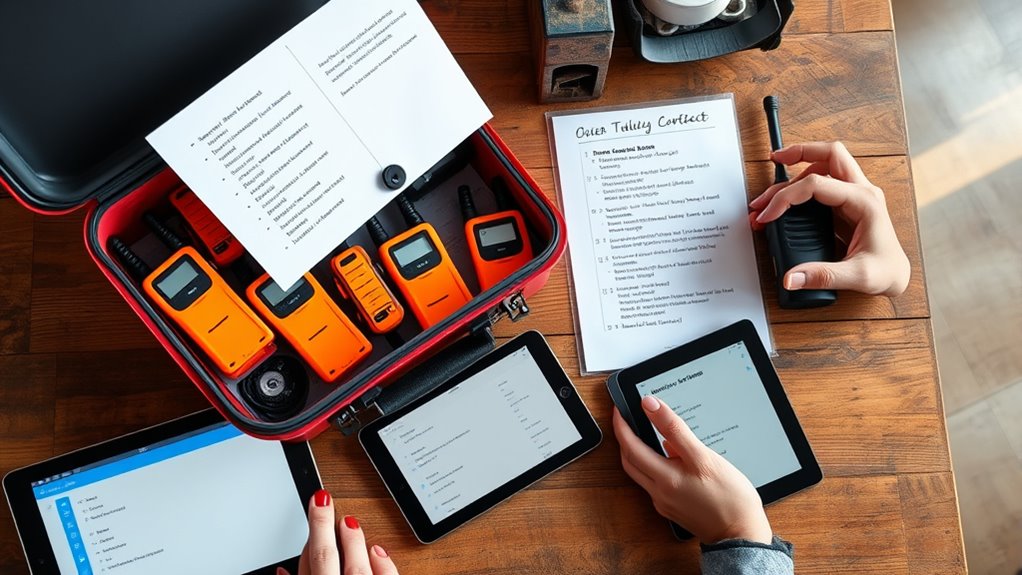
Ensuring your communication devices work properly is essential for effective emergency response. Regular communication testing helps confirm that your radios, cell phones, and other devices are functional. Additionally, updating contact information ensures you can reach out to family, friends, or emergency services when needed. Using self watering plant pots as a metaphor, regularly checking and maintaining your communication devices ensures they stay “hydrated” and ready for use when an emergency occurs. Here’s what you should do:
Regularly test and update your communication devices to stay prepared for emergencies.
- Test your radios and cell phones to verify they power on and transmit clearly.
- Confirm that all communication devices are within range and working properly.
- Update contact lists, emergency contacts, and service provider info to reflect current details.
- Save important contact numbers in multiple devices to prevent loss if one fails.
Performing these steps keeps your communication devices reliable and your contact information current, so you’re prepared for any emergency.
Review Clothing and Bedding for Wear and Tear

Have you checked your clothing and bedding recently for signs of wear and tear? Inspect your clothing for holes, thinning fabric, or fading, which can reduce clothing durability and leave you unprotected. Replace or repair items that show significant damage. For bedding, examine the condition of blankets, sleeping bags, and sheets—look for frayed edges, stains, or thinning material that indicates reduced bedding condition. Damaged bedding won’t keep you warm or comfortable when you need it most. Verify all clothing and bedding are intact and suitable for emergency use. If anything appears compromised, replace it promptly. Maintaining the integrity of your clothing and bedding ensures you stay warm, protected, and comfortable during an emergency. Regular reviews help keep your kit reliable and ready.
Ensure Important Documents Are Current and Accessible
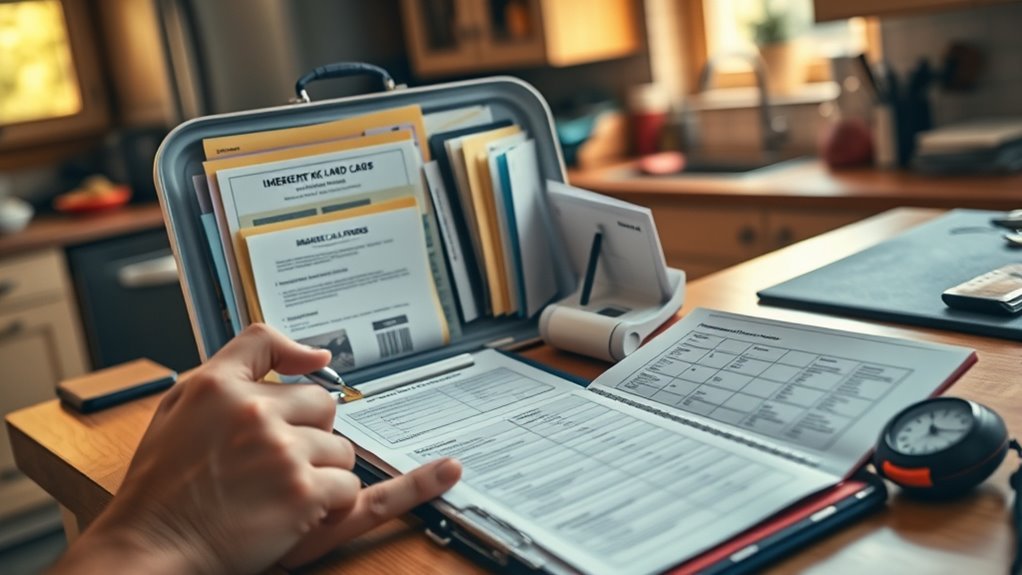
Keeping your important documents current and accessible is essential for effective emergency preparedness. Proper document organization ensures you can quickly find what you need during a crisis. Accessibility planning means storing these documents where they’re safe but easy to reach. To do this, check your files and update any expired or outdated information, such as ID cards, insurance policies, and medical records. Consider creating digital copies stored securely online or on a thumb drive. Keep physical copies in a waterproof, fireproof container. Here’s what to review: Signs of spoilage include checking for discoloration, off-smell, and separation. Verify all personal identification and insurance documents are current. Ensure copies are organized in a designated, accessible location. Confirm digital backups are updated and stored securely. Test how quickly you can access these documents in an emergency.
Confirm the Presence and Condition of Emergency Tools and Equipment

To stay prepared for emergencies, you need to verify that all your emergency tools and equipment are present and in good working condition. Check each item for signs of damage or wear, performing emergency tool maintenance as needed. Ensure batteries are charged and flashlights work, and replace expired or malfunctioning gear. Use effective equipment storage solutions to keep everything organized and accessible. Regular checks guarantee your kit’s readiness when it counts. Empathetic guidance can help you approach this task calmly and confidently.
Organize and Restock Items as Needed for Easy Access
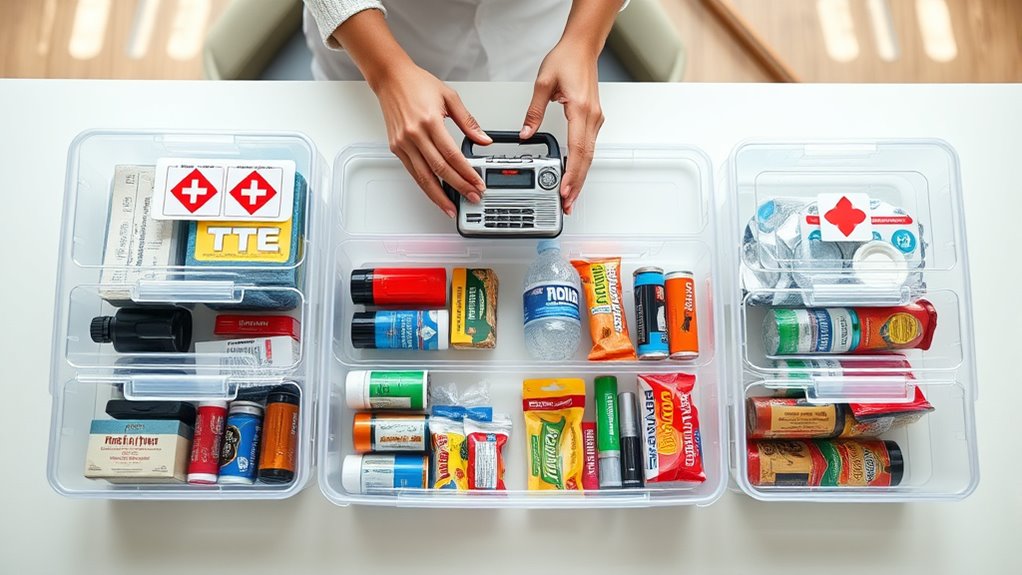
Once you’ve confirmed that all your emergency tools and equipment are in good shape, the next step is to organize and restock them for quick, easy access. Focus on storage organization and accessibility improvements to guarantee you can grab what you need without delay. Consider these steps:
- Use labeled containers or bins to categorize items like first aid supplies, tools, and water.
- Place frequently used items at the front or top of storage for faster access.
- Regularly check expiration dates and restock supplies as needed.
- Keep your kit in a dedicated, easily reachable spot, avoiding clutter that could slow you down.
- Incorporate effective organization techniques to optimize your kit’s layout and improve response time during emergencies.
This organized setup minimizes search time during emergencies, ensuring you’re always prepared.
Create a Quick-Reference Checklist for Ongoing Maintenance
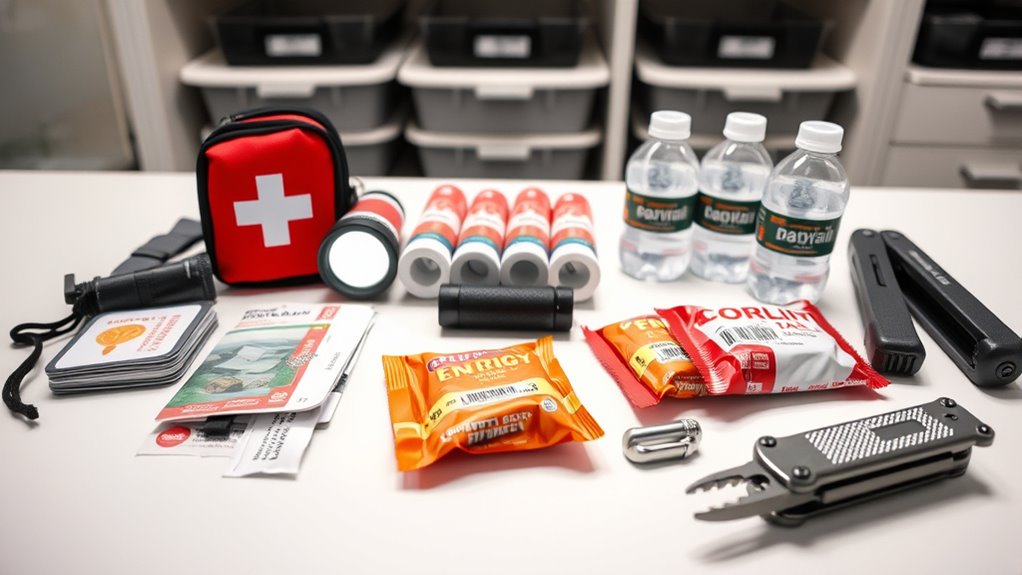
Creating a quick-reference checklist for ongoing maintenance guarantees you stay on top of your emergency kit’s readiness. This checklist should include storage organization tips to keep supplies accessible and in good condition. Regularly review and update your checklist to reflect any changes, such as expired items or new essentials. Keep your storage organized so you can quickly locate what’s needed during an emergency. Schedule routine inspections—monthly or quarterly—to verify contents, replace expired items, and adjust for family needs. Updating your checklist ensures it remains accurate and thorough, saving you time when emergencies strike. A well-maintained, easy-to-follow checklist becomes your go-to tool for consistent upkeep, making sure your emergency preparedness kit is always ready when it matters most. Incorporating effective maintenance practices helps prolong the lifespan of supplies and ensures reliability during critical moments.
Frequently Asked Questions
How Often Should I Perform a Full Emergency Kit Review?
You should perform a full emergency kit review at least twice a year to guarantee your supply inventory is current and your kit maintenance is up to date. Regular checks help you identify expired items and replenish supplies before an emergency occurs. Set reminders to review your kit, ideally every six months, and after any major weather event or emergency. This keeps your kit reliable and ready whenever you need it.
What Are Indicators That Supplies Need Replacement Before Expiration Dates?
Did you know that nearly 40% of emergency kit supplies are discarded prematurely? You should monitor expiration dates regularly and perform container integrity checks. If items appear discolored, swollen, or damaged, replace them immediately. Also, check for leaks or corrosion in containers. These indicators mean supplies are compromised and may not work during an emergency, so staying vigilant guarantees your kit remains reliable when you need it most.
How Can I Organize My Kit for Quick Access During an Emergency?
To organize your kit for quick access, use a clear labeling system on all containers and supplies, so you can find what you need instantly. Implement accessibility strategies like keeping essential items at eye level and grouping similar items together. Regularly review and update the layout to guarantee everything remains easy to reach. Practice locating items so you’re prepared to grab your kit swiftly during an emergency.
Are There Recommended Storage Locations to Prevent Damage or Theft?
Choose a secure, easily accessible location like a locked cabinet or closet for your emergency kit. Make certain it’s protected against environmental damage by storing it in a cool, dry spot away from direct sunlight, humidity, or pests. Use lockable containers or safes to enhance storage security, preventing theft or tampering. Regularly check your storage area for any signs of damage or security issues to keep your kit ready for any emergency.
What Are Essential Items to Include in a Basic Emergency Preparedness Kit?
You should include essential items like a first aid kit and water purification supplies in your emergency kit. First aid items help you treat injuries quickly, while water purification tablets or filters guarantee safe drinking water. Also, pack non-perishable food, a flashlight, extra batteries, and a whistle for signaling. Keep these essentials organized and accessible, so you’re prepared to handle emergencies efficiently and stay safe until help arrives.
Conclusion
So, there you have it—your emergency kit’s now more foolproof than your grandma’s secret recipe. With everything checked, replaced, and organized, you’re practically a prepper superstar. Just don’t forget to update that quick-reference list—because nothing says “prepared” like realizing you’re out of batteries during a blackout. Stay vigilant, stay sane, and remember: if chaos hits, at least your kit won’t be the disaster. Cheers to being slightly over-prepared!

